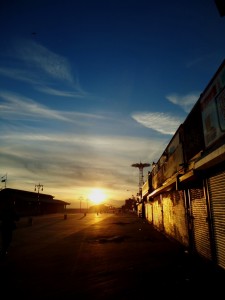 “Twenty two stops to the city, 22 stops…” Garland Jeffreys voice kicks in, joining the drum’s beat on “Coney Island Winter,” his new single from his terrific album The King of In Between, a lament and love letter to New York City.
“Twenty two stops to the city, 22 stops…” Garland Jeffreys voice kicks in, joining the drum’s beat on “Coney Island Winter,” his new single from his terrific album The King of In Between, a lament and love letter to New York City.
Brooklyn-born Jeffreys is a New York City storyteller who uses music to lay his story down. His introspective autobiographical songs use the city as a character. Listen to “New York Skyline,” “Ghost Writer,” or “Mystery Kids.” You cannot separate him from the city or the city from who he is. Even when New York is not mentioned by name, you sense it in the words and the characters of his songs.
 Garland Jeffreys pens love songs and laments for his beloved New York City.
Garland Jeffreys pens love songs and laments for his beloved New York City.
The Manhattan resident’s cultural background is black, white and Puerto Rican. He grew up (22 subway stops from the city) in Sheepshead Bay in a multi-ethnic neighborhood where his was the only family of color in his local Catholic church. This racial diversity underlines and at times punctuates his music.
Over coffee last year in a First Avenue cafe, he told me, “Growing up in that multi-national neighborhood in a large and loving extended family was a blessing. It readied me for the world. I’ve always mixed well with people.” In the restaurant, I saw evidence of this when he warmly greeted the wait-staff with waves and a smile. Easy to see why he counts Bruce Springsteen and Lou Reed as close friends.
Jeffreys is married to Claire Jeffreys, a writer and his business manager. Their daughter, Savannah, 15, pens her own music. Being there for his family is the central reason he’s been out of the musical limelight for several years.
“I did not want to be on the road all the time,” he said. “I wanted to watch my daughter grow up.”
After a long period of retreating from the music business, he came to see performing as the most important facet of his musical identity, and little by little that led to a desire to get back to writing new material.
Hearing Jeffreys’ stories, seeing the city through his eyes, visualizing his “Racial Repertoire,” gave me a desire to engage other cultures and consider the race issue from both sides. This readied me when I went to work for city government and comfortably adjusted to the cultural diversity there.
In June 1992, I drove my brother, Rory, upstate to a rehab program. Not for the first time. He and I tried hard to become closer as brothers, but we couldn’t make it work. I loved Rory, but didn’t know him. At the same time, I was having personal problems and was about to change jobs. I came home to New York City miserable. The next day, I read that Jeffreys was giving a free concert at Summerstage in Central Park. I felt so low that I almost didn’t go.
Jeffreys played for two hours. The cops were dancing by the third song. It was a gorgeous day and people whirling around sent the dust on the floor of the space into the air, where it stayed for the entire show. I wrote my first story when I was 49, eight years ago. The seed to write that story was planted in Central Park in 1992 at that show.
Do yourself a favor and pick up “The King of In Between,” one of 2011 best records. Critics universally loved it.
The New Yorker loved it, read below.
The New Yorker
June 13, 2011 | POP NOTES | Wild Borough | by Ben Greenman
Rock and roll is like a religion for heretics, and Garland Jeffreys has been a true unbeliever for decades. He made his name in the seventies with a series of tough, smart albums that moved confidently between rock, soul, and reggae, yielding songs like “Wild in the Streets,” “Ghost Writer,” and “Modern Lovers.” As he matured, his work became more essayistic and autobiographical; “Don’t Call Me Buckwheat,” from 1992, explored his mixed-race upbringing in Brooklyn, the civil-rights era, and the integrationist power of popular music.
Jeffreys’s new album, “The King of In Between”(Luna Park), stays true to what made his reputation in the first place. The cover photo, by Anton Corbijn, shows the intersection of Dr. Martin Luther King, Jr., Boulevard and Malcolm X Boulevard, in Harlem, and that spirit animates the record: it’s both humble and defiant, nostalgic and restless. It opens with “Coney Island Winter,” a stark but hopeful portrait of the outer reaches of Brooklyn (“twenty-two stops to the city”) that ends with an aging rocker’s wish (“Don’t want to die onstage / with a microphone in my hand”). The second song, “I’m Alive,” is an anthemic tale of surviving early stardom and foolhardy youth.
Most of the album is spent coming to terms with old(er) age, and with the fact that rock and roll still serves as a fountain of youth. “Rock and Roll Music” celebrates the ability of the art form to clarify and uplift; “’Til John Lee Hooker Calls Me” reaches back into soul, blues, and jazz, allowing Jeffreys to express his admiration for artists such as James Brown, Nat King Cole, and Louis Armstrong. Elsewhere, Jeffreys is a home-town booster (in “Roller Coaster Town,” he notes that he was “born a thousand yards from the Cyclone”), a worried parent (in “Streetwise,” he hopes that he has taught his daughter how to survive in the city), and a philosopher (in “The Beautiful Truth,” he muses on the value of error, like a Zen Dylan). On the funky “The Contortionist,” which is reminiscent of the Rolling Stones’ “Miss You,” Lou Reed provides backup vocals, as does Jeffreys’s teen-age daughter, Savannah, but it’s Jeffreys’s show, and the lyrics are among the album’s most personal: “I used to be a contortionist / Doing that and doing this / Swallowing rings and swords and things / Life was bent and I was twisted.”












KLM220
cool, I’ll have to check out garland jeffreys more 🙂 thank you for this!